Adam D. Roberts's Blog
May 18, 2023
Sassy Strawberry Sorbet
When strawberries are season (like they are now), you have a few options. Option one: eat them raw. Option two: eat them raw dipped in homemade whipped cream. Option three: Strawberry Shortcake. All of these are totally reasonable options — especially option three (which I plan to make this weekend for a friend’s birthday) — only, are they the most strawberry-forward options? Well, the raw strawberries, yes. You don’t get more strawberry-forward than a raw strawberry. Or do you? What if you blend them and perk them up with sugar, lemon juice, and a few other secret ingredients and then give them a spin in an ice cream maker? You’ll wind up with something even better than a raw strawberry. You’ll wind up with my sassy strawberry sorbet.
Start with the Sweetest Strawberries
Strawberries can be deceptive. Just because they’re red, just because they’re at the farmer’s market, doesn’t mean that they’re actually good. Your best bet is to bite into one (ask permission, if you must) and see if the strawberry sings. If it’s giving strawberry aria, you’re ready to sorbet! If not, then maybe the time isn’t right yet. In that case, make chocolate sorbet and let’s come back to this later.
Blend ‘Em Up
Don’t show David Lebovitz this picture: I’m going to get yelled at for cutting the strawberries the wrong way! You’re actually supposed to hull them. I even have the right knife for it. But some of us have children to raise (okay, I don’t) and dogs to walk (I do), so forgive me my slicing method. The point is: they go into the food processor and you blend them. It’s really not that hard.
And then you add sugar and lemon juice and blend again.
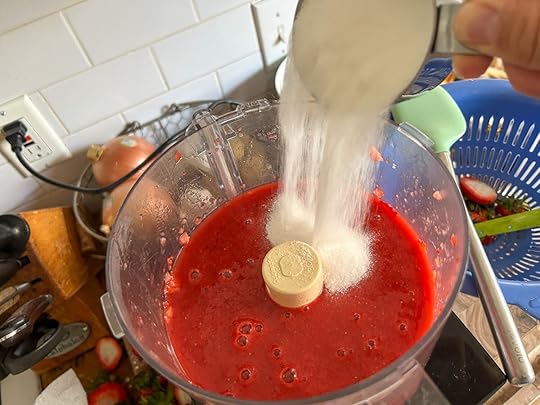
How much sugar? For two quarts of strawberries, you want one cup. Truthfully, I didn’t really measure here: I just hulled (sliced) three pints of strawberries, blended them, and added a cup of sugar and the lemon juice and tasted. It tasted good! That’s how I knew I was on to something.
Pssst… A Few Secret Ingredients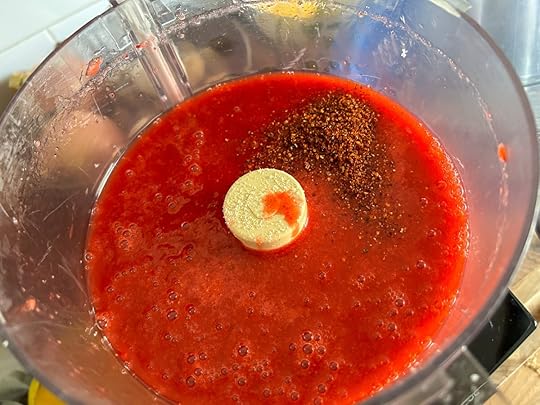
When I tasted my strawberries and sugar and lemon I liked it, but I was a little bored. So first, I did what Ina Garten might do and I added a splash of Framboise. She’s always adding Framboise to things. Framboise is a raspberry liqueur, so isn’t exactly a strawberry flavor, but it’s a berry flavor and a little alcohol in sorbet is a good thing. It keeps things soft.
Then, on a whim, I decided to add some Kashmiri chili powder and some Aleppo pepper. I liked the idea of a warming heat that takes my customer (or dinner party guest) by surprise. I added a little at first, and tasted, and then I added a little more. Basically I just stood there adding chili and tasting strawberry liquid until I was happy.
Netflix and Churn
After straining the sorbet base (make sure to press with a rubber spatula to get all the liquid through), I chilled it in the fridge for two hours and then churned. When it finished churning — see lead photo — it was pure joy to taste a little off my tasting spoon and to see how the chilies and lemon juice and Framboise all helped the strawberries pop. This sorbet was alive, baby!
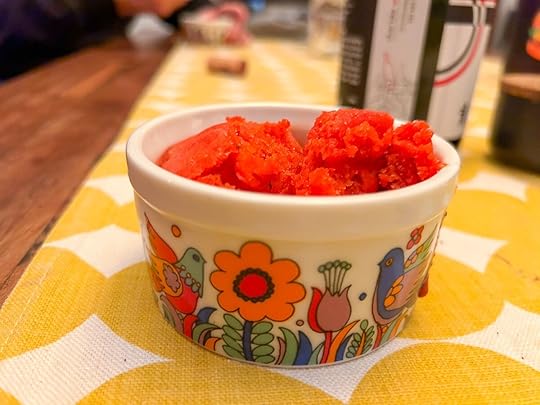
When I served this at dinner that night, my friend Ryan went nuts for it. “You should sell this!” he said. “For real… people would go crazy for it.” He loved it so much that he took the rest of it home (with my permission).
So give my Sassy Strawberry Sorbet a try. As an alternative to the Kashmiri chili powder, you could add a red chili to the food processor along with the strawberries. If you do that, let me know! We’re all open to new experiences here at Sassy Strawberry Sorbet headquarters.
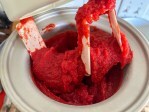 PrintSassy Strawberry SorbetMy spicy spin on a traditional springtime strawberry sorbet.Course DessertCuisine AmericanKeyword chilies, frozen, lemon, sorbet, strawberriesPrep Time 2 hours hours 20 minutes minutesCook Time 30 minutes minutesServings 1 quartIngredients2 quarts strawberries, washed and hulled1 cup sugarJuice of one lemon1/2 teaspoon kosher salt1 tablespoon Framboise1 teaspoon Kashmiri chili powder, plus more to taste1 teaspoon Aleppo pepper, plus more to tasteInstructionsPlace your hulled strawberries in the bowl of a food processor and process until the whole thing is liquid and smooth. Add the sugar, half the lemon juice, and salt and blend again. Taste and add more lemon juice if it needs it.Now for the fun: add the Framboise, the Kashmiri chili powder, and Aleppo pepper. Blend and taste. Adjust for heat — if you like it sassier, go for it.Strain the mixture (I like to do it into a large measuring glass), cover, and chill for at least two hours. Then churn in your ice cream maker according to your ice cream maker instructions (at least 20 minutes; you'll know it's done when the whole thing looks like sorbet). Scoop into a quart container and freeze for a few more hours, before serving.
PrintSassy Strawberry SorbetMy spicy spin on a traditional springtime strawberry sorbet.Course DessertCuisine AmericanKeyword chilies, frozen, lemon, sorbet, strawberriesPrep Time 2 hours hours 20 minutes minutesCook Time 30 minutes minutesServings 1 quartIngredients2 quarts strawberries, washed and hulled1 cup sugarJuice of one lemon1/2 teaspoon kosher salt1 tablespoon Framboise1 teaspoon Kashmiri chili powder, plus more to taste1 teaspoon Aleppo pepper, plus more to tasteInstructionsPlace your hulled strawberries in the bowl of a food processor and process until the whole thing is liquid and smooth. Add the sugar, half the lemon juice, and salt and blend again. Taste and add more lemon juice if it needs it.Now for the fun: add the Framboise, the Kashmiri chili powder, and Aleppo pepper. Blend and taste. Adjust for heat — if you like it sassier, go for it.Strain the mixture (I like to do it into a large measuring glass), cover, and chill for at least two hours. Then churn in your ice cream maker according to your ice cream maker instructions (at least 20 minutes; you'll know it's done when the whole thing looks like sorbet). Scoop into a quart container and freeze for a few more hours, before serving.The post Sassy Strawberry Sorbet appeared first on The Amateur Gourmet.
May 8, 2023
Best Sticky Buns Ever
Hyperbole on a food blog? Well I never! Look: I’ve eaten many a sticky bun in my day (that sounded dirty) and the best sticky buns I’ve ever experienced were the ones that I ate in my kitchen just two days ago when I made the Sticky Sticky Buns from Joanne Chang’s essential Flour cookbook. But, to quote Reading Rainbow, don’t take my word for it. When Joanne Chang went on Beat Bobby Flay in Battle Sticky Bun, these buns went home with the trophy. They’re as much a Boston landmark as Faneuil Hall — I ate one when I visited Craig last summer. But nothing can compete with eating them warm out of your own oven. They really are the best sticky buns ever.
You Oughta Dough
There’s one hiccup to this recipe: you have to make another recipe to make it.
No, don’t click away! That other recipe — Joanne Chang’s recipe for Brioche dough — is such a pleasure to make and, if you have a KitchenAid mixer, a total piece of cake…err, brioche. If you do what I did and divide the dough in half, you can leave this experience with a loaf of professional-grade brioche (for French Toast, for grilled cheese, for croutons) PLUS a batch of the best sticky buns you’ll ever eat.

As you can see, the first step for making sticky buns is to roll out the brioche into a rectangle 16 X 12 inches wide. You might notice that my rectangle wasn’t a perfect rectangle and that was a mistake because when you roll it up, the curved in parts short-shrift that person’s sticky bun experience. You want each sticky bun to have as many layers as you can manage.
Dust It, Roll It, Slice It

If you watch a lot of The Great British Baking Show, as I do, you’ll have seen those bakers roll up a jelly roll for Paul Hollywood to ridicule. This one, though, was a pleasure to roll up. After dusting with sugar, cinnamon, and toasted chopped pecans (don’t skip toasting them! It draws out the flavor), you roll from the far end towards yourself. Because the brioche is so well developed (see brioche recipe), it’s firm and pliant and easier to deal with than a sleeping bag.
Once rolled, you slice off the ends and then slice into eight equal-sized pieces.

Isn’t that pretty? Even Paul Hollywood would shake my hand. Now let’s make goo.
For Gooey Sticky Buns, You Need Goo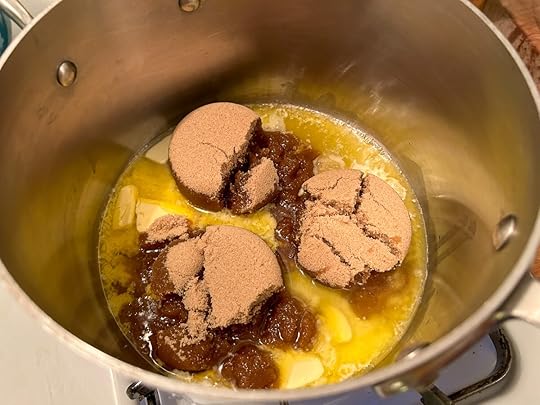
I live in a goo-oriented household. As in, if I make pasta with tomato sauce or a salad with lots of bits and I bring Craig his portion, he’ll almost always say: “Needs more goo.” Then he’ll go spoon on more tomatoes, more bits, etc. That’s why I love that Joanne Chang just comes right out and calls this stuff what it is: the goo.

You make the goo with brown sugar, butter, honey, heavy cream, water, and salt, you pour it into a 9X13 baking dish, you dust it with the rest of the pecans, and then top with your sliced up buns. I made these the night before and refrigerated so I could just bring to room temperature the next morning before baking.
Rise Up and Get Baked
That’s what the sticky buns looked like the next morning when I took them out of the refrigerator and let them rise for two hours. They’re supposed to touch, but because I cut off too much of the ends when it was a log, they weren’t equally sized.
Turns out, that didn’t matter because once I baked them for 35 minutes in a 350 oven, they baked up beautiful and golden.

If you could scratch and sniff the screen, you’d want to do that right now. These made the apartment smell so good.
Sticky Buns Ready to Go
You have to let these cool for 25 minutes and then you flip them out and spoon on all of the extra goo. Sometimes a picture just speaks for itself, so I’ll let you gaze upon these sticky buns and see if you agree that they’re the best ever. And once you’ve realized that they’re the pillowiest, stickiest, most complex and satisfying sticky buns you’re likely to encounter, you can make the recipe!
Related: Brioche for Beginners
 PrintBest Sticky Buns EverThe undisputed best sticky buns ever from Joanne Chang's Flour cookbook.Course BreadCuisine AmericanKeyword baking, breakfast, sticky bunsPrep Time 2 hours 30 minutesCook Time 35 minutesServings 8 bunsIngredientsFor the goo:3/4 cup unsalted butter (1 1/2 sticks of butter)1 1/2 cups light brown sugar1/3 cup honey1/3 cup heavy cream1/3 cup water1/4 teaspoon kosher saltFor the buns:1/2 batch Basic Brioche dough The recipe is in my post "Brioche for Beginners," linked above1/4 cup packed light brown sugar1/4 cup granulated sugar1/2 teaspoon cinnamon1 cup pecan halves, toasted and choppedInstructionsStart by making the goo. In a sauce pan, melt the butter over medium heat. Whisk in the brown sugar and cook until it dissolves. Off the heat, whisk in the honey, cream, water, and salt. Let cool for 30 minutes.On a floured work surface, roll out the dough into a rectangle about 16 by 12 inches and 1/4-inch thick. Position the rectangle so a short side is facing you.In a small bowl, stir together the brown sugar, granulated sugar, cinnamon, and half of the pecans. Sprinkle it over the entire surface of the dough. Starting from the short side farthest from you, roll up the rectangle like a jelly roll. Roll it tightly so you have a nice round spiral. Slice off 1/4 inch from both ends to even things out.Using a bench scraper or a chef's knife, cut the roll into 8 equal pieces. (I did this by cutting it in half, cutting each half in half, and then once again.) Pour the goo into a 9X13-inch baking dish, covering the bottom evenly. Sprinkle the remaining pecans over the surface. Place the buns, cut-side down and evenly spaced, in the baking dish. Cover with plastic wrap and place in a warm spot to proof for two hours, or until the dough is puffy and the buns are touching.Heat the oven to 350 degrees. Bake the buns for 35. to 45 minutes or until they're golden brown. Remove from the oven and let cool on a wire rack for 20 to 30 minutes. Using a spatula, carefully flip them out on to a serving platter one at a time. Spoon any extra goo on top. They're best right away or within 4 hours of baking.
PrintBest Sticky Buns EverThe undisputed best sticky buns ever from Joanne Chang's Flour cookbook.Course BreadCuisine AmericanKeyword baking, breakfast, sticky bunsPrep Time 2 hours 30 minutesCook Time 35 minutesServings 8 bunsIngredientsFor the goo:3/4 cup unsalted butter (1 1/2 sticks of butter)1 1/2 cups light brown sugar1/3 cup honey1/3 cup heavy cream1/3 cup water1/4 teaspoon kosher saltFor the buns:1/2 batch Basic Brioche dough The recipe is in my post "Brioche for Beginners," linked above1/4 cup packed light brown sugar1/4 cup granulated sugar1/2 teaspoon cinnamon1 cup pecan halves, toasted and choppedInstructionsStart by making the goo. In a sauce pan, melt the butter over medium heat. Whisk in the brown sugar and cook until it dissolves. Off the heat, whisk in the honey, cream, water, and salt. Let cool for 30 minutes.On a floured work surface, roll out the dough into a rectangle about 16 by 12 inches and 1/4-inch thick. Position the rectangle so a short side is facing you.In a small bowl, stir together the brown sugar, granulated sugar, cinnamon, and half of the pecans. Sprinkle it over the entire surface of the dough. Starting from the short side farthest from you, roll up the rectangle like a jelly roll. Roll it tightly so you have a nice round spiral. Slice off 1/4 inch from both ends to even things out.Using a bench scraper or a chef's knife, cut the roll into 8 equal pieces. (I did this by cutting it in half, cutting each half in half, and then once again.) Pour the goo into a 9X13-inch baking dish, covering the bottom evenly. Sprinkle the remaining pecans over the surface. Place the buns, cut-side down and evenly spaced, in the baking dish. Cover with plastic wrap and place in a warm spot to proof for two hours, or until the dough is puffy and the buns are touching.Heat the oven to 350 degrees. Bake the buns for 35. to 45 minutes or until they're golden brown. Remove from the oven and let cool on a wire rack for 20 to 30 minutes. Using a spatula, carefully flip them out on to a serving platter one at a time. Spoon any extra goo on top. They're best right away or within 4 hours of baking.The post Best Sticky Buns Ever appeared first on The Amateur Gourmet.
May 7, 2023
Brioche for Beginners
I’m currently listening to Julia Child’s memoir, My Life in France, on Audible. I’m embarrassed it to say that it took me this long; I suppose I thought I already knew the story because I’ve watched both Julie & Julia (multiple times) and Julia (which I really loved; I interviewed the showrunner, Daniel Goldfarb, on my podcast). But there’s something undeniable about hearing Julia tell her story in her own words. The wonderment that she felt upon arriving in France and experiencing not just the famous sole meunière but the cheeses and the sauces and the breads totally reignited my own Francophilia. And that’s why I found myself, on a Saturday afternoon, whipping up brioche from scratch like a real boulanger.
Give Your Mixer a Workout
The recipe that I used — Joanne Chang’s from her Flour cookbook — is a masterclass in specificity. At one point she says the dough should feel like “cold, clammy Play-Doh” and at another point she says it should feel like “a water balloon.” It made the brioche-making process a total cinch. The other thing that made it a cinch? My KitchenAid Mixer.
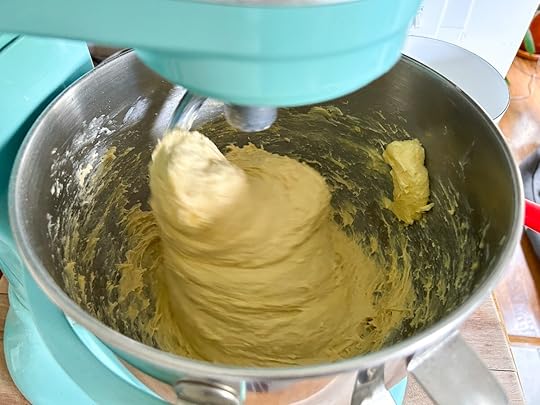
That’s the thing. If you have a KitchenAid mixer? There’s nothing to this recipe. In the bowl of the mixer, you stir together all-purpose flour, bread flour, active dry yeast, a little sugar, kosher salt, cold water, and five eggs. You let the machine work that with a dough hook for a while and then you start slowly adding 2 3/4 sticks of room temperature butter. As each little piece goes in you let the machine take its time incorporating it and then you crank up the machine and then you crank it up even more and my poor machine was so hot at the end, I felt bad for it! It was like Short Circuit, the food version.
Give Your Dough a Rest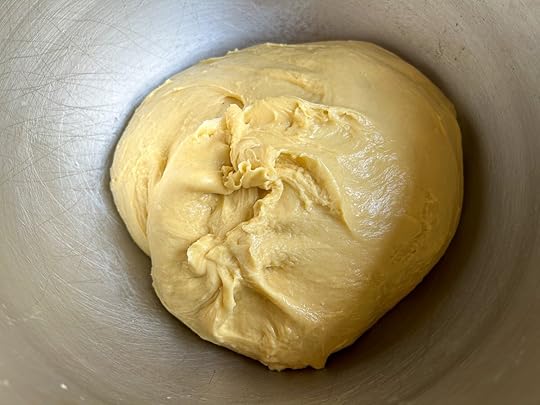
That’s what finished brioche dough looks like before you let it rise for six hours (to overnight) in the refrigerator. I went to dinner then a musical (I’m gay, what can I say) and when I came home, this is what I found waiting for me.

Look at that bulbous blob! I could just imagine Julia trilling: “Oh goody!”
As I Lay Me Down to Sleep, I Pray the Lord My Dough to Keep
Right before bed, I got to work. Because after you shape it, the dough takes another 4 to 5 hours at room temperature, I wanted a head start. So I followed the instructions to divide the dough in half (the other half went to the best sticky buns I’ve ever made; that’s my next post!), pat the dough into a square, then fold it like an envelope. I placed it crease-side down in a greased loaf pan, covered with plastic, and refrigerated overnight.
Getting a Rise Out of You
Then, this morning I took it out of the fridge and let it come to room temperature for a few hours while I went to the farmer’s market, worked the Sunday Times crossword puzzle (Ship of Theseus), and by the time the dough reached the top of the pan, I brushed it with egg and baked it in a 350 oven for 35 minutes. And look at this beauty.
My Big Bad Beautiful Brioche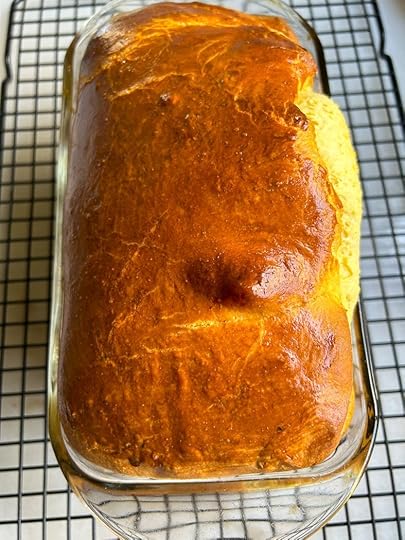
I’m so proud of my first brioche and I have such big plans for it! Grilled cheese one day (with Gruyere and caramelized onions and mustard), French Toast the next, and maybe just a slice as a treat.
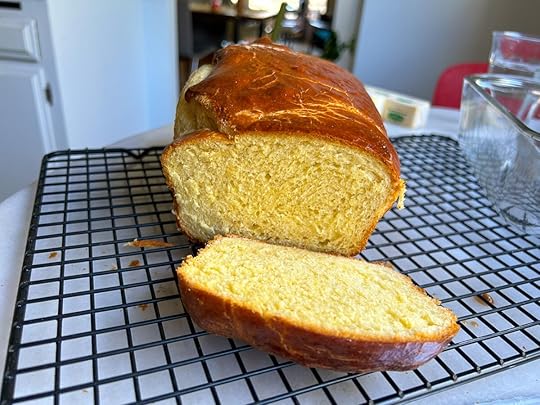
Turns out making your own brioche isn’t just easy, it’s a total joy. I can’t wait to do it again. Bon Appetit!
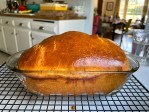 PrintBrioche for BeginnersA foolproof recipe for brioche from Joanne Chang's Flour cookbook.Course BreadCuisine FrenchKeyword bread-making,, brioche, French, Joanne ChangPrep Time 13 hoursCook Time 35 minutesIngredients2 1/4 cups unbleached all-purpose flour (315 grams) I used a scale to measure the ingredients… much more accurate! 2 1/4 cups bread flour (340 grams)1 1/2 packages active dry yeast1/3 cup plus 1 tablespoon sugar (82 grams)1 tablespoon kosher salt1/2 cup cold water (120 grams)6 large eggs1 cup plus 6 tablespoons unsalted butter at room temperature, cut into 10 to 12 pieces (310 grams) That's 2 + 3/4 sticksInstructionsPlace your dough hook in your stand mixer (you're really going to need a stand mixer for this) and combine the all-purpose flour, bread flour, yeast, sugar, salt, water, and 5 of the eggs. Beat on low speed for 3 to 4 minutes, or until all of the ingredients have come together. Every so often stop and scrape down the sides of the bowl. Once the dough has come together, beat on low speed for another 3 to 4 minutes. The dough will be stiff and seem quite dry. On low speed, add the butter one piece at a time, taking your time to let the butter disappear after each addition. Continue until you've used up all the butter and then keep mixing on low speed for about 10 minutes, scraping the bowl as necessary. Your goal: get all of the butter incorporated into that dough, even if you have to use your hands.Once the butter's completely incorporated, turn up the speed to medium and beat for another 15 minutes, or until the dough becomes sticky, soft, and somewhat shiny. It will take some time to come together. (It may look shaggy at first, but will turn smooth and silky eventually.) After that, turn the speed up to medium-high and beat for 1 minute. The dough should make slapping sounds against the side of the bowl. If it seems wet and loose, add a few tablespoons of flour and mix until it comes together. It's ready when you can gather it all together and pick it up in one piece.Place in a large bowl or plastic container and cover it with plastic wrap, pressing the wrap directly on top of the dough. Let the dough proof in the refrigerator for at least 6 hours or overnight. Remove the dough from the fridge and divide it in half. If you want to use half to make sticky buns, pop that half back in the bowl and refrigerate until you're ready. Otherwise, line two 9-by-5-inch loaf pans with parchment or just spray them with cooking spray (that's what I did). Press the dough into a 9-inch square (it'll feel like "cold, clammy Play-Doh"). Facing the square, fold down the top one-third toward you, and then fold up the bottom one-third, as if folding a letter. Press to join these layers. Turn the folded dough over and place it, seam-side down, in one of the prepared pans. Repeat with the second piece of dough, if you're doing two.Cover lightly with plastic and place in a warm spot to proof for 4 to 5 hours, or until the loaves have nearly doubled in size. They should have risen to the rim of the pan and be rounded on top. Position a rack in the center of the oven and heat to 350 degrees F.In a small bowl, whisk the remaining egg until blended. Gently brush the tops of the loaves with the beaten egg.Bake for 35 to 45 minutes, or until the tops and sides of the loaves are completely golden brown. Let cool in the pans on wire racks for 30 minutes, then turn the loaves out of the pans and continue to cool on the racks. The bread can be stored tightly wrapped in plastic wrap at room temperature for up to 3 days or in the freezer for up to one month.
PrintBrioche for BeginnersA foolproof recipe for brioche from Joanne Chang's Flour cookbook.Course BreadCuisine FrenchKeyword bread-making,, brioche, French, Joanne ChangPrep Time 13 hoursCook Time 35 minutesIngredients2 1/4 cups unbleached all-purpose flour (315 grams) I used a scale to measure the ingredients… much more accurate! 2 1/4 cups bread flour (340 grams)1 1/2 packages active dry yeast1/3 cup plus 1 tablespoon sugar (82 grams)1 tablespoon kosher salt1/2 cup cold water (120 grams)6 large eggs1 cup plus 6 tablespoons unsalted butter at room temperature, cut into 10 to 12 pieces (310 grams) That's 2 + 3/4 sticksInstructionsPlace your dough hook in your stand mixer (you're really going to need a stand mixer for this) and combine the all-purpose flour, bread flour, yeast, sugar, salt, water, and 5 of the eggs. Beat on low speed for 3 to 4 minutes, or until all of the ingredients have come together. Every so often stop and scrape down the sides of the bowl. Once the dough has come together, beat on low speed for another 3 to 4 minutes. The dough will be stiff and seem quite dry. On low speed, add the butter one piece at a time, taking your time to let the butter disappear after each addition. Continue until you've used up all the butter and then keep mixing on low speed for about 10 minutes, scraping the bowl as necessary. Your goal: get all of the butter incorporated into that dough, even if you have to use your hands.Once the butter's completely incorporated, turn up the speed to medium and beat for another 15 minutes, or until the dough becomes sticky, soft, and somewhat shiny. It will take some time to come together. (It may look shaggy at first, but will turn smooth and silky eventually.) After that, turn the speed up to medium-high and beat for 1 minute. The dough should make slapping sounds against the side of the bowl. If it seems wet and loose, add a few tablespoons of flour and mix until it comes together. It's ready when you can gather it all together and pick it up in one piece.Place in a large bowl or plastic container and cover it with plastic wrap, pressing the wrap directly on top of the dough. Let the dough proof in the refrigerator for at least 6 hours or overnight. Remove the dough from the fridge and divide it in half. If you want to use half to make sticky buns, pop that half back in the bowl and refrigerate until you're ready. Otherwise, line two 9-by-5-inch loaf pans with parchment or just spray them with cooking spray (that's what I did). Press the dough into a 9-inch square (it'll feel like "cold, clammy Play-Doh"). Facing the square, fold down the top one-third toward you, and then fold up the bottom one-third, as if folding a letter. Press to join these layers. Turn the folded dough over and place it, seam-side down, in one of the prepared pans. Repeat with the second piece of dough, if you're doing two.Cover lightly with plastic and place in a warm spot to proof for 4 to 5 hours, or until the loaves have nearly doubled in size. They should have risen to the rim of the pan and be rounded on top. Position a rack in the center of the oven and heat to 350 degrees F.In a small bowl, whisk the remaining egg until blended. Gently brush the tops of the loaves with the beaten egg.Bake for 35 to 45 minutes, or until the tops and sides of the loaves are completely golden brown. Let cool in the pans on wire racks for 30 minutes, then turn the loaves out of the pans and continue to cool on the racks. The bread can be stored tightly wrapped in plastic wrap at room temperature for up to 3 days or in the freezer for up to one month. The post Brioche for Beginners appeared first on The Amateur Gourmet.
May 3, 2023
Seared Scallops on Sugar Snap Cacio e Pepe
There are certain culinary rules that people memorize like they’re gospel, even though they’re not really rules and those who adhere to them are doing it more out of fear than logic. Case in point: cheese and fish. “In Italy, you never put cheese on fish!” No less an authority than Lidia Bastianich has disproven this on her show where she explains traditions regarding fish and cheese have more to do with geography than gastronomy. (Don’t believe me? Here’s her recipe for a seafood gratin.) Generally, I never put cheese on fish because fish is so delicate. But every so often, if there’s seafood involved with a pasta, I may sprinkle on a little Parmesan. And thus this recipe for seared scallops with sugar snap cacio e pepe was born.
It’s Not Really a Cacio e Pepe

Since I’m already in trouble with the cheese and fish thing, I won’t fall on another sword: this isn’t a textbook cacio e pepe.
For that, I highly recommend this Mark Ladner recipe where you toast the peppercorns in a dry skillet, add pasta cooking water, then thicken it with butter before adding the pasta and then the cheese.
Here, I had some gorgeous sugar snap peas and after stringing them and cutting them in half on the diagonal, I sautéed them in olive oil with lots of garlic, then stopped the cooking with pasta water. To finish, I added a knob of butter, a bunch of black pepper, and a handful of grated Parmesan (off the heat). Just by itself, it was sublime. But I knew a way to make it even better.
Seared Scallops for Serious Scallop Searers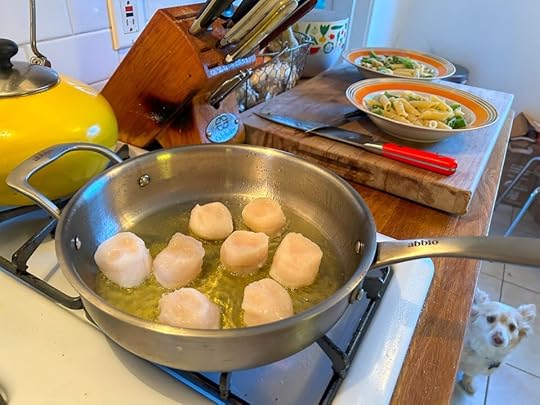
There’s only one way to sear a scallop and that’s this: don’t move it.
DON’T. MOVE. IT.
I’m not joking. Buy dry-packed scallops (they shouldn’t be sitting in liquid), pat them with paper towels, and season with salt and pepper. Then in a skillet wide enough to hold them all in a single layer, heat a layer of olive oil until very hot. Then carefully add your scallops and walk away. Go do a dish or two. Text your mother back. When you’ve walked away for at least a minute, come back and grab a spoon. If you can flip a scallop over with a spoon without having to tug, you’ve done a good job.
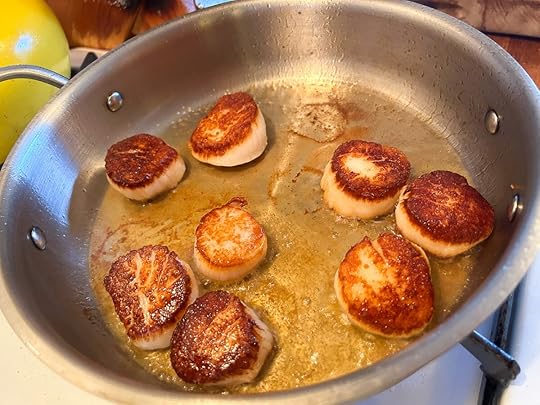
I mean, can you imagine more perfectly seared scallops than these? I can’t! On the other side, just cook until opaque (another 15 seconds or so). And that’s that.
Plate it Up, Heather
To serve, it’s as simple as this. Spoon the pasta into bowls, top the bowls with the scallops, and squeeze some lemon juice on top. Grind some pepper and, if you must, dust with more Parmesan. Did I do that? No I didn’t. You have to draw the line somewhere.
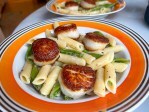 PrintSeared Scallops on Sugar Snap Cacio e PepeA springy pasta dish with seafood that breaks a few rules along the way.Course Main CourseCuisine ItalianKeyword pasta, scallopsPrep Time 30 minutesCook Time 26 minutesServings 2 peopleIngredientsKosher salt1/2 pound penne or spaghetti or any other pasta you like1/2 cup extra-virgin olive oil, divided4 cloves garlic, thinly slicedRed chili flakes1/2 pound sugar snap peas, strings removed, sliced in half on the diagonal2 tablespoons butter, salted or unsalted, doesn't matterFreshly ground black pepper1/2 cup freshly grated Parmesan cheese8 dry-packed scallops, patted dryFreshly squeezed lemon juiceInstructionsBring a large pot of water to a boil and season with salt. It should taste like good soup, but not so salty that it tastes like the ocean. About a few tablespoons, depending on how much water.Drop your pasta into the water and at the same time, pour 1/4 cup of olive oil into a skillet. Add the garlic and toast on medium heat just until the garlic starts to take on a little color. Add a pinch of red chili flakes, then all of the sugar snaps. Toss all around until thoroughly coated and starting to soften a little. Then add a ladleful of pasta cooking water and allow to simmer and reduce as the pasta continues to cook. Lower the heat if too much evaporates. When the pasta is cooked to your liking (see package instructions), lift it with a spider tool into the pan with the sugar snap peas and toss all around. Add the butter and black pepper and continue tossing until thoroughly coated. Off the heat, add the Parmesan cheese and stir aggressively until well incorporated. Taste for seasoning and set aside.In a large skillet (cast iron, metal, even non-stick will work), heat the remaining 1/4 cup of olive oil until very hot. Meanwhile season the scallops with salt and pepper and then add them, flat side down, in one layer. They should sizzle immediately upon hitting the skillet. Don't move them — leave them alone! — until you can see they're golden brown on the bottom. Using a spoon see if you can detach the scallop without having to tug. If it flips over by itself, it's ready. Flip all the scallops that way and cook on the other side just until the scallop is no longer translucent, about 15 seconds.Spoon the pasta into bowls and top with the scallops. Squeeze lemon juice on top and add more pepper, if you like. Serve right away.
PrintSeared Scallops on Sugar Snap Cacio e PepeA springy pasta dish with seafood that breaks a few rules along the way.Course Main CourseCuisine ItalianKeyword pasta, scallopsPrep Time 30 minutesCook Time 26 minutesServings 2 peopleIngredientsKosher salt1/2 pound penne or spaghetti or any other pasta you like1/2 cup extra-virgin olive oil, divided4 cloves garlic, thinly slicedRed chili flakes1/2 pound sugar snap peas, strings removed, sliced in half on the diagonal2 tablespoons butter, salted or unsalted, doesn't matterFreshly ground black pepper1/2 cup freshly grated Parmesan cheese8 dry-packed scallops, patted dryFreshly squeezed lemon juiceInstructionsBring a large pot of water to a boil and season with salt. It should taste like good soup, but not so salty that it tastes like the ocean. About a few tablespoons, depending on how much water.Drop your pasta into the water and at the same time, pour 1/4 cup of olive oil into a skillet. Add the garlic and toast on medium heat just until the garlic starts to take on a little color. Add a pinch of red chili flakes, then all of the sugar snaps. Toss all around until thoroughly coated and starting to soften a little. Then add a ladleful of pasta cooking water and allow to simmer and reduce as the pasta continues to cook. Lower the heat if too much evaporates. When the pasta is cooked to your liking (see package instructions), lift it with a spider tool into the pan with the sugar snap peas and toss all around. Add the butter and black pepper and continue tossing until thoroughly coated. Off the heat, add the Parmesan cheese and stir aggressively until well incorporated. Taste for seasoning and set aside.In a large skillet (cast iron, metal, even non-stick will work), heat the remaining 1/4 cup of olive oil until very hot. Meanwhile season the scallops with salt and pepper and then add them, flat side down, in one layer. They should sizzle immediately upon hitting the skillet. Don't move them — leave them alone! — until you can see they're golden brown on the bottom. Using a spoon see if you can detach the scallop without having to tug. If it flips over by itself, it's ready. Flip all the scallops that way and cook on the other side just until the scallop is no longer translucent, about 15 seconds.Spoon the pasta into bowls and top with the scallops. Squeeze lemon juice on top and add more pepper, if you like. Serve right away.The post Seared Scallops on Sugar Snap Cacio e Pepe appeared first on The Amateur Gourmet.
May 2, 2023
Chicken and Rapini Stir-Fry
Some people collect matchbooks from restaurants, others dinner napkins. Me? I collect cookbooks from the restaurants I’ve been to. On my shelf, you’ll find a Spanish language version of the El Bulli cookbook we collected on our trip there. There are cookbooks from Prune, St. John, Mozza, Lucques, and so many others, too many to list here. One that I bought last summer was the Myers + Chang At Home Cookbook which I bought after our terrific dinner at Myers + Chang in Boston. Not only is a restaurant cookbook a great reminder of your dinner there, it’s full of recipes that’ll conjure up that meal through similar flavors, textures, smells. Like this chicken and rapini stir-fry.
She Used an Itsy-Bitsy Teeny-Weeny Head of Bitter Green Rapini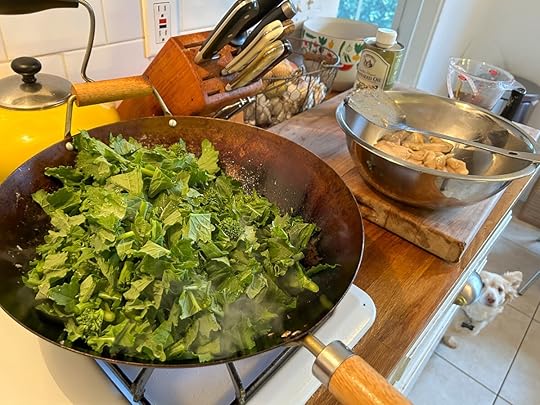
What I loved about our meal at Myers & Chang was the everything was familiar yet different at the same time. Like the scallion pancakes. I couldn’t get them out of my mind, they were so good, but they didn’t taste like any scallion pancakes I’d had before. Then I found a video of Chef Joanne Chang making them and the secret was… they’re made from pizza dough. Isn’t that wild? Everything was like that. The carrot cake was so good, I don’t even have words.
But we’re here to talk about the recipe that I just made from the Myers + Chang cookbook. Chicken and rapini stir-fry. What’s rapini? It’s like broccoli but a lot more bitter; like your hippie uncle who spent a year in Afghanistan handing out flours and came back angry and broken. Wow, that was dark.

Instead of your typical beef and broccoli or chicken and broccoli stir-fry, Myers + Chang utilize rapini’s bitterness to create more balance in the dish. Plus there’s Napa cabbage in there too for a little extra crunch and sweetness.
The Chicken Part of the Chicken and Rapini Stir-Fry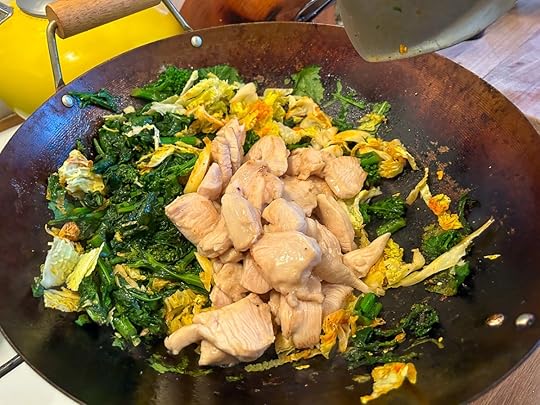
Now the original recipe asks you to do something cheffy. It asks you to “velvet” the chicken by coating it in Chinese wine, corn starch, and egg white and then deep-frying it in two cups of oil.
That seemed like a lot for a Monday night, so I coated the chicken breast pieces in Mirin (that was all I had) and corn starch, left out the egg white, and instead of deep-frying, I just sautéed the chicken in a wok the way I normally would. And somehow, it still worked. The marinade made the chicken breast super tender. And I took it out just when it turned opaque. Nothing worse than a dry chicken breast.
Let’s Talk Stir-Fry Sauce
I have some excellent condiments in my fridge (so many, the middle shelf broke and needs to be replaced). The Momofuku Soy Sauce I couldn’t resist when I was ordering things from Good Eggs. And the oyster sauce that was recommended by Ruth Reichl in her newsletter.
The only annoying thing here is you have to mix it together and then cook it before you add it to the wok, dirtying another pot. Do you really need to do that? Between you and me, maybe not. But the resulting sauce is glossy and unctuous (world’s worst food word) and gives you all of that glazed, umami you want in a stir-fry.

As it cooks down, it coats everything but enough still remains to pour over your rice.
Let’s Doctor Our Bowl, Doctor
I served this over brown rice which I cooked in my rice cooker (it took forever; literally ninety minutes!). I topped it with cilantro and Momofuku Chili Crunch, also on Good Eggs (no they’re not sponsoring this post). Be careful with that stuff; I ate it while we watched The Real Housewives of New Jersey and my mouth was so on fire, I almost toppled over a table.
But this was such a good dinner and a great justification for buying restaurant cookbooks as souvenirs. Now who wants to make me the carrot cake?
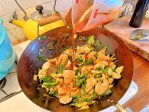 PrintChicken and Rapini Stir-FryA robust and satisfying stir-fry of chicken and rapini from the Myers + Chang cookbook.Course Main CourseCuisine ChineseKeyword chicken breast, rapini, stir-fryPrep Time 30 minutesCook Time 4 minutesServings 4IngredientsFor the Chicken Stir-Fry Sauce:1 tablespoon cornstarch1/4 cup oyster sauce1/4 cup low-sodium soy sauce1/4 cup basic chicken stock I used water and it was fineFor the chicken and rapini stir-fry:1 tablespoon cornstarch1 tablespoon Shaoxing cooking wine or dry sherry or dry white wine1 pound boneless, skinless chicken breast, cut thinly into 2 X 1/4-inch strips1/4 cup vegetable oil1 pound rapini, trimmed and cut into 2-inch pieces The bottom of the rapini is really tough so I just discard it, though some people shave it down2 cups thinly sliced Napa cabbage1 teaspoon freshly ground black pepper1 teaspoon red pepper flakes1 teaspoon chili oil1 cup fresh cilantro leavesCooked brown rice or white rice InstructionsFor the Chicken Stir-Fry Sauce:In a small bowl, whisk together the cornstarch and 4 tablespoons cold water with a fork until smooth. Set aside.In a medium saucepan, bring the oysters sauce, soy sauce, and stock to a boil over medium-high heat. Whisk in the cornstarch slurry until the sauce thickens and becomes shiny, 3 to 4 minutes. Set the sauce aside.For the stir-fry:In a medium bowl, stir together the corn starch and the Shaoxing wine. Add the chicken strips and use your hands to coat the chicken thoroughly in the mixture. Marinate for at least 30 minutes. Heat a wok over high heat until very hot. Swirl in the 2 tablespoons of the oil, coating the sides of the wok, and then add your chicken (leave any residual liquid behind). Stir-fry the chicken until it goes from pink to white and immediately remove the chicken to a plate. It'll cook again later.Swirl in another 2 tablespoons of vegetable oil and carefully add the rapini (if it's at all wet, it'll crackle and spurt). Stir for 1 minute to coat with the oil. Add 1/2 cup water to the wok and cover. Cook for about 5 minutes until the rapini is wilted and no longer raw and bitter tasting.Add the napa cabbage and season with the black pepper, red pepper flakes, and chili oil. Stir a few times and return the chicken to the wok. Stir for 2 minutes.Add the Chicken Stir-Fry Sauce and toss until the chicken and rapini are nicely covered in sauce and the chicken is cooked through, 3 to 4 minutes more. Add cilantro and toss one last time. Divide the stir-fry among four bowls and serve with rice.
PrintChicken and Rapini Stir-FryA robust and satisfying stir-fry of chicken and rapini from the Myers + Chang cookbook.Course Main CourseCuisine ChineseKeyword chicken breast, rapini, stir-fryPrep Time 30 minutesCook Time 4 minutesServings 4IngredientsFor the Chicken Stir-Fry Sauce:1 tablespoon cornstarch1/4 cup oyster sauce1/4 cup low-sodium soy sauce1/4 cup basic chicken stock I used water and it was fineFor the chicken and rapini stir-fry:1 tablespoon cornstarch1 tablespoon Shaoxing cooking wine or dry sherry or dry white wine1 pound boneless, skinless chicken breast, cut thinly into 2 X 1/4-inch strips1/4 cup vegetable oil1 pound rapini, trimmed and cut into 2-inch pieces The bottom of the rapini is really tough so I just discard it, though some people shave it down2 cups thinly sliced Napa cabbage1 teaspoon freshly ground black pepper1 teaspoon red pepper flakes1 teaspoon chili oil1 cup fresh cilantro leavesCooked brown rice or white rice InstructionsFor the Chicken Stir-Fry Sauce:In a small bowl, whisk together the cornstarch and 4 tablespoons cold water with a fork until smooth. Set aside.In a medium saucepan, bring the oysters sauce, soy sauce, and stock to a boil over medium-high heat. Whisk in the cornstarch slurry until the sauce thickens and becomes shiny, 3 to 4 minutes. Set the sauce aside.For the stir-fry:In a medium bowl, stir together the corn starch and the Shaoxing wine. Add the chicken strips and use your hands to coat the chicken thoroughly in the mixture. Marinate for at least 30 minutes. Heat a wok over high heat until very hot. Swirl in the 2 tablespoons of the oil, coating the sides of the wok, and then add your chicken (leave any residual liquid behind). Stir-fry the chicken until it goes from pink to white and immediately remove the chicken to a plate. It'll cook again later.Swirl in another 2 tablespoons of vegetable oil and carefully add the rapini (if it's at all wet, it'll crackle and spurt). Stir for 1 minute to coat with the oil. Add 1/2 cup water to the wok and cover. Cook for about 5 minutes until the rapini is wilted and no longer raw and bitter tasting.Add the napa cabbage and season with the black pepper, red pepper flakes, and chili oil. Stir a few times and return the chicken to the wok. Stir for 2 minutes.Add the Chicken Stir-Fry Sauce and toss until the chicken and rapini are nicely covered in sauce and the chicken is cooked through, 3 to 4 minutes more. Add cilantro and toss one last time. Divide the stir-fry among four bowls and serve with rice.The post Chicken and Rapini Stir-Fry appeared first on The Amateur Gourmet.
April 30, 2023
Reverse-Seared Ribeyes
Remember that scene in Mary Poppins where they all go up the chimney and come out all sooty? That’s what my dinner guests usually look like when I cook steak. The whole kitchen fills up with black clouds as I sear the meat in a large cast-iron skillet, flipping and continuing to cook while frantically taking the temperature to make sure I stop in time to hit medium-rare. Sometimes I get it right on the first go; other times, I serve the steak and somebody politely says: “Ummm, sorry, but is it supposed to be blue inside?” That all changed this past Saturday when I cooked my usual steakhouse dinner for our friends Marcos and John, only this time the kitchen wasn’t full of smoke and the steaks came out absolutely perfect. The secret? Reverse-seared ribeyes.
The Easiest Steak Cookery You Will Ever Do
Do you see the image above? That’s the extent of what you have to do to reverse sear. There’s no stock pot where you mimic a sous vide, no vacuum sealer that you have to pack the meat into. You just line a sheet pan with foil (you don’t even need to do that, it just makes clean up easier), place a rack on top, and then place two ribeyes on top. They should be at least an inch thick — these were about 1.4″. Season all over with salt and pepper (be generous… that’s a lot of meat to season). Then wait for them to come to room temperature, about 30 minutes.
Preheat the oven to 250 and then insert your sheet tray and cook for 20 to 25 minutes until a thermometer reads 115 (that’s for medium rare, which is what you want) when inserted into the thickest parts of the steak. That’s it. To reiterate: put meat on a rack, season the meat, put it in a 250 oven, cook 25 minutes until it’s 115 in the thickest parts. Now you just have to sear it.
Searing the Reverse-Sear Ribeyes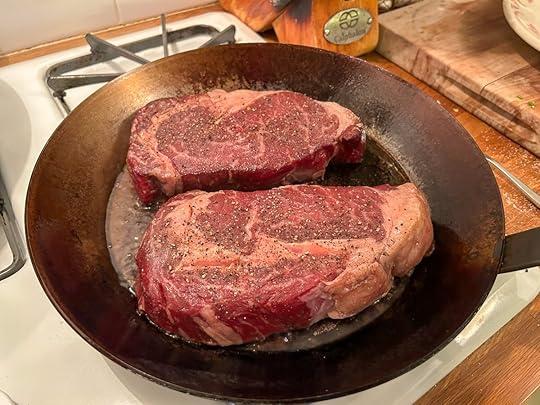
For this step, get out your largest cast iron skillet or carbon steel skillet (that’s what I have here) and heat on high heat until super hot. Add a splash of vegetable oil and then lay in your ribeyes directly from the oven. They should immediately sizzle.
Your goal here is just to get color on the outside. The steaks are basically cooked; you just want to cook on one side until golden, flip, and then keep cooking until you get to an internal temperature of 130 for medium-rare (140 for medium). Once that happens, you immediately remove the steak and slice into it, against the grain. No need to rest it!

Look at that color. Can you even? Ribeye doesn’t get much better than that!
Serving Up Your Ribeyes
I like to make a green salsa verde / chimichurri kind of thing by chopping a bunch of parsley, two cloves of garlic, and some pickled red chilies until very very finely minced. Then I stir that together with lemon zest, lemon juice, and enough olive oil to make a thick paste.
To serve up the steaks, I lifted some slices on to each plate and then topped each portion with the green sauce.

As for the other stuff: that’s a little gem salad with homemade Roquefort dressing and roasted fingerling potatoes with Parmesan. Our dinner guests were very happy indeed!

Now that I’ve reverse-seared ribeyes, I’m never looking back. No more clouds of smoke, no more questionable doneness. Chim-chiminee indeed.
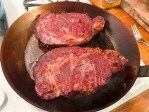 PrintReverse-Seared RibeyesA technique for getting perfectly cooked ribeye steaks every time.Prep Time 5 minutesCook Time 35 minutesServings 4 peopleIngredientsFor the ribeyes:2 large ribeyes, around 1 pound each, at least 1" thickKosher saltFreshly ground black pepperFor the green herb sauce:1 bunch Italian flat-leaf parsley2 cloves garlic, peeled and sliced2 pickled red chilies or one fresh red chili 1 lemon1/2 cup extra-virgin olive oilTo finish the steaks:Vegetable oilInstructionsPreheat the oven to 250. Place a wire rack on top of a foil-lined cookie sheet. Place the ribeyes on top, pat dry with paper towels, then season generously with kosher salt and pepper (rain it down like a chef!). Let sit for 20 to 30 minutes to come to room temperature.Insert the sheet pan into the oven and cook for 20 to 25 minutes until a thermometer inserted into the thickest part reads 115 for medium-rare (for medium, shoot for 125).While the steaks are cooking, make your green sauce. Roughly scrape the leaves off the parsley stems (it's okay if a few stems get in there). Lay them on a cutting board and place the garlic and chilies on top. Using your sharpest knife chop chop chop and keep chopping — it'll take a few minutes — until everything is finely minced. Add the mixture to a bowl and zest the lemon over it, add the lemon juice, add a pinch of salt, and then stir in the olive oil until it's pasty but not so thick it won't spill off a spoon. Set aside.When the ribeyes reach the right temperature, heat a large cast iron skillet or carbon steel skillet on high heat until you can't hold your hand near it without it getting too hot, then add a splash of vegetable oil. Lay in your ribeyes straight from the oven and let them sear on the first side without moving them for 30 seconds to a minute. When they detach easily and are golden brown, flip them over and finish on the second side until a thermometer reads 130 for medium-rare and/or 140 for medium.Immediately slice the ribeyes against the grain, place on to a platter, and spoon the sauce on top. Serve right away.
PrintReverse-Seared RibeyesA technique for getting perfectly cooked ribeye steaks every time.Prep Time 5 minutesCook Time 35 minutesServings 4 peopleIngredientsFor the ribeyes:2 large ribeyes, around 1 pound each, at least 1" thickKosher saltFreshly ground black pepperFor the green herb sauce:1 bunch Italian flat-leaf parsley2 cloves garlic, peeled and sliced2 pickled red chilies or one fresh red chili 1 lemon1/2 cup extra-virgin olive oilTo finish the steaks:Vegetable oilInstructionsPreheat the oven to 250. Place a wire rack on top of a foil-lined cookie sheet. Place the ribeyes on top, pat dry with paper towels, then season generously with kosher salt and pepper (rain it down like a chef!). Let sit for 20 to 30 minutes to come to room temperature.Insert the sheet pan into the oven and cook for 20 to 25 minutes until a thermometer inserted into the thickest part reads 115 for medium-rare (for medium, shoot for 125).While the steaks are cooking, make your green sauce. Roughly scrape the leaves off the parsley stems (it's okay if a few stems get in there). Lay them on a cutting board and place the garlic and chilies on top. Using your sharpest knife chop chop chop and keep chopping — it'll take a few minutes — until everything is finely minced. Add the mixture to a bowl and zest the lemon over it, add the lemon juice, add a pinch of salt, and then stir in the olive oil until it's pasty but not so thick it won't spill off a spoon. Set aside.When the ribeyes reach the right temperature, heat a large cast iron skillet or carbon steel skillet on high heat until you can't hold your hand near it without it getting too hot, then add a splash of vegetable oil. Lay in your ribeyes straight from the oven and let them sear on the first side without moving them for 30 seconds to a minute. When they detach easily and are golden brown, flip them over and finish on the second side until a thermometer reads 130 for medium-rare and/or 140 for medium.Immediately slice the ribeyes against the grain, place on to a platter, and spoon the sauce on top. Serve right away.The post Reverse-Seared Ribeyes appeared first on The Amateur Gourmet.
April 26, 2023
Spicy Merguez with Spinach and Borlotti Beans
Every so often you encounter a recipe that grabs you by the throat and won’t let go. That was the case when I was thumbing through an old book in my collection: Daniel Boulud’s Braise, which he co-wrote with Melissa Clark back in 2013. This is one of those books that’ve survived many a cookbook cut because (a) braising is my favorite cooking technique (so much reward for such little effort); and (b) the recipes in it are fascinating. Like this recipe for Spicy Merguez with Spinach and Beans. It’s not that shocking to imagine lamb sausage, spinach, and beans together; but the technique is what left me shooketh.
I’m Strong to the Finich, ‘Cause I Eats Me Spinach
This recipe calls for four pounds of spinach. To put that into perspective, that image you see above? That’s two pounds of spinach. The idea of buying eight giant plastic containers of spinach was too much, even for me, so I decided to halve the greenery.

As anyone who’s worked in the Spinach Department before knows, even two pounds of spinach cooks down to almost nothing. What’s odd about this recipe, and what made me sit up and pay attention, is that you just cook the spinach by itself in olive oil. And then, once it’s wilted and released all its liquid and starting to brown, you add the aromatics.
Bring on the Flavah!
As you can see, Daniel Boulud has many tools in his arsenal to spice up your spinach. For starters: harissa. Then a ton of garlic, onions, cilantro, mint (I couldn’t find the mint I bought and by the time I did, it was too late), and Four-Spice powder which I mimicked using small spoonfuls of ground ginger, grated nutmeg, a pinch of cloves, and lots of black pepper.

Again: that all goes in once the spinach is wilted. The recipe doesn’t say to, but I seasoned things as I went because I’m almost positive that’s what a four-star chef like Daniel Boulud does too. (Though maybe he doesn’t have you season because of the theory that salt inhibits the cookery of beans? But that’s been disproven.)
Beans, Beans, The Special Beans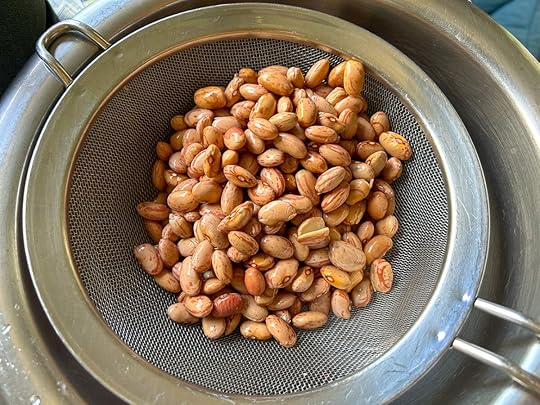
As dedicated readers may recall, I recently ordered Borlotti Beans from Italy as part of a package that I bought from Gustiamo (it led to this article about pistachios for Food52). This recipe calls for dried cannellini beans or dried black eyed peas, but knowing that the cook time was in the same ballpark, I soaked the borlottis (which are also known as cranberry beans) overnight and then added them to the mix, along with four cups of water and a good pinch of salt.
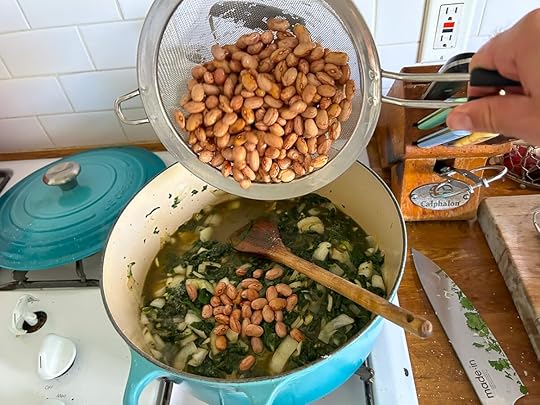
I think it’s important to use soaked dried beans here because canned beans will disintegrate with all of the cooking this is about to do. This goes into the oven, lid on, for two hours.
Bring on the Meat, Or Don’t
Two hours later you have something pretty extraordinary. All of those aromatics that you added after the spinach, instead of sautéing them first, infuse into the liquid which infuses into the spinach and the beans, creating a harmonious whole that’s greater than the sum of its parts. I checked things about halfway through the cooking and saw a lot of liquid in there, so for the remainder I braised with the lid a bit off so things would thicken up a bit.
At this point, you could serve this as a vegetarian side dish or even a main with some rice and cheese. For the carnivores, though, things are about to get meaty. Bring on the merguez!

As you can see, the process here is pretty simple. You sear the merguez (spicy lamb sausage) in a skillet and when it’s brown all over, you lay it on top of the spinach (which you stir a little lemon juice into first), before putting the lid back on and returning it to the oven for thirty more minutes.
A One-Pot Dinner — Except for That Skillet You Seared the Sausages In — But Otherwise It’s a One-Pot Dinner
What I love about this dish is that it transcends seasons. Yes, we eat a lot of lamb in the spring; true, spinach is also something that emerges as it gets warmer out. But because these ingredients are available year-round, you can honestly make this on a cold winter’s night or a rainy summer’s eve, it doesn’t matter.
And believe me when I tell you: it’s so good. The spinach pops with vibrant flavors, the beans are succulent from their two hour braise, and the lamb marries beautifully with the harissa and lemon. See? Thumbing through old cookbooks is a perfectly good use of your time. Now tell that to my husband who wants me to get rid of half of them before we move!
 PrintSpicy Merguez with Spinach and Borlotti BeansA thrilling recipe from Daniel Boulud's cookbook Braise: A Journey Through International Cuisine.Course Main CourseCuisine FrenchKeyword garlic, harissa, lemon, merguez, spinachPrep Time 30 minutesCook Time 3 hoursServings 4 peopleIngredients1/4 cup extra-virgin olive oil, plus 1 tablespoon2 pounds baby spinach, washed and dried The original recipe calls for four pounds of regular spinach, stems removed, but two pounds of baby spinach worked great.Kosher salt2 medium onions, peeled and cut into small cubes6 garlic cloves, peeled and finely chopped2 tablespoons chopped fresh mint leaves2 tablespoons chopped fresh cilantro1 tablespoon harissa I used a harissa paste from a tube.1 teaspoon freshly ground black pepper1/2 teaspoon four-spice powder I just added small amounts of ground cloves, ground ginger, and freshly grated nutmeg to supplement.1/2 pound dried borlotti beans, cannellini beans, or black-eyed peas, soaked overnight in cold water and drained2 pounds merguez sausage1/4 cup freshly squeezed lemon juiceInstructionsCenter a rack in the oven and preheat the oven to 300 degrees F.Heat 1/4 cup of the olive oil in a wide Dutch oven over high heat. Add the spinach, little by little (seasoning with salt every so often), and cook, stirring continuously, until all the spinach has wilted and browned slightly and all the liquid has evaporated, 20 to 30 minutes. Add the onions, garlic, mint, cilantro, harissa, black pepper, and Four-Spice Powder and cook, with a pinch of salt, stirring, for 5 minutes.Pour in 4 cups water and add the beans or black-eyed peas. Add another big pinch of salt, stir, bring to a simmer, and cover. Braise in the oven for 2 hours or until the beans are nearly tender.When the spinach is done and tasting good, heat the remaining 1 tablespoon olive oil in a medium skillet over medium heat. Sear the merguez on all sides until golden brown. Stir the lemon juice into the beans and spinach and place the seared merguez on top. Cover and continue to braise until the beans are tender and the sausage is cooked through, about 30 minutes more. Season with salt to taste.NotesAs I mentioned in the post, I found the spinach and beans were a bit too liquidy after an hour of braising, so I took the lid half off in order for some of the liquid to evaporate. Keep your eye on it as it goes. You don’t want soup here, but you also don’t want a solid mass of spinach and beans.
PrintSpicy Merguez with Spinach and Borlotti BeansA thrilling recipe from Daniel Boulud's cookbook Braise: A Journey Through International Cuisine.Course Main CourseCuisine FrenchKeyword garlic, harissa, lemon, merguez, spinachPrep Time 30 minutesCook Time 3 hoursServings 4 peopleIngredients1/4 cup extra-virgin olive oil, plus 1 tablespoon2 pounds baby spinach, washed and dried The original recipe calls for four pounds of regular spinach, stems removed, but two pounds of baby spinach worked great.Kosher salt2 medium onions, peeled and cut into small cubes6 garlic cloves, peeled and finely chopped2 tablespoons chopped fresh mint leaves2 tablespoons chopped fresh cilantro1 tablespoon harissa I used a harissa paste from a tube.1 teaspoon freshly ground black pepper1/2 teaspoon four-spice powder I just added small amounts of ground cloves, ground ginger, and freshly grated nutmeg to supplement.1/2 pound dried borlotti beans, cannellini beans, or black-eyed peas, soaked overnight in cold water and drained2 pounds merguez sausage1/4 cup freshly squeezed lemon juiceInstructionsCenter a rack in the oven and preheat the oven to 300 degrees F.Heat 1/4 cup of the olive oil in a wide Dutch oven over high heat. Add the spinach, little by little (seasoning with salt every so often), and cook, stirring continuously, until all the spinach has wilted and browned slightly and all the liquid has evaporated, 20 to 30 minutes. Add the onions, garlic, mint, cilantro, harissa, black pepper, and Four-Spice Powder and cook, with a pinch of salt, stirring, for 5 minutes.Pour in 4 cups water and add the beans or black-eyed peas. Add another big pinch of salt, stir, bring to a simmer, and cover. Braise in the oven for 2 hours or until the beans are nearly tender.When the spinach is done and tasting good, heat the remaining 1 tablespoon olive oil in a medium skillet over medium heat. Sear the merguez on all sides until golden brown. Stir the lemon juice into the beans and spinach and place the seared merguez on top. Cover and continue to braise until the beans are tender and the sausage is cooked through, about 30 minutes more. Season with salt to taste.NotesAs I mentioned in the post, I found the spinach and beans were a bit too liquidy after an hour of braising, so I took the lid half off in order for some of the liquid to evaporate. Keep your eye on it as it goes. You don’t want soup here, but you also don’t want a solid mass of spinach and beans.The post Spicy Merguez with Spinach and Borlotti Beans appeared first on The Amateur Gourmet.
April 24, 2023
Wining and Dining Our Way Up the California Coast, from Los Angeles to Sonoma
We’ve lived in Los Angeles for twelve years (moved here in 2011!) and in all of that time, we’ve only taken one legitimate road trip up the coast… and that was during the pandemic when we escaped to Washington State to see my husband Craig’s family. On that odyssey, we stopped in Carmel, which was a beautiful respite from the monotony of our apartment, though it was also stressful because we were all in masks. That’s why, with the big news that we’re moving back to NYC in September, we decided to take a totally spontaneous road trip from Los Angeles to Sonoma. And we had such a blast, I thought I’d lay it all out for you here, in case you happen to be in L.A. and are craving a road trip of your own.
Day One: L.A. to CarmelWe set off at about ten o’clock for the first leg of our journey and took the 101 (last time, we took U.S. 1 which was curvy and beautiful, but a leg of it is now closed because of a landslide).
For lunch, we stopped off at Metropulos in Santa Barbara, a much-loved destination for sandwiches. Craig had one with turkey; I ordered a salad with grilled chicken (should’ve ordered a sandwich) and we sat outside on a day so perfect, it was almost obnoxious. We grabbed coffee (and a pistachio baklava) next door at Dart Coffee Co. and then hit the road again.


Back on the road, it was just a few hours to Carmel. Going in April is a great time to go, especially midweek (we arrived on a Wednesday): the temperature was just a little cool, and the streets were almost empty. We checked into our lovely hotel — L’Auberge (we used Amex points to book it) — and we were greeted with a beguiling and delicious chai-spiced grape juice, before they showed us to our room.


The hotel is elegant without being over-the-top. Our room had a four-poster bed and a marble bathroom and fresh cookies that they put in a little basket. There’s no air conditioning, but it’s totally fine because you open the window and get a nice gust of ocean breeze.
For dinner that night, we’d heard tell of a local spot called La Bicyclette. I thought that they didn’t take reservations; apparently, they do: you make via a phone call, whatever that is? Luckily, on this not-so-busy night, they found a table for us and we enjoyed a local favorite.


We really liked the grilled little gem appetizer, but for me the highlight was the mushroom pizza. Our waitress suggested we order it with the gnocchi (seen behind the pizza), because we could dip the crust in the cream sauce. Good tip! We also ordered half a bottle of Pinot Noir (it came in a mini bottle) and that was cute.
Day Two: Carmel to Monterey to BerkeleyThe next morning, we met Craig’s friends Sam and Amy (who live in Carmel) at a spot they recommended, Carmel Belle, which definitely seemed like an in-the-know kind of place.


I had a most excellent smoked salmon sandwich (Craig had the green eggs and ham, not pictured) and then we set off for the Monterey Bay Aquarium, which was only a short twenty minute drive away.


Truly one of the world’s great aquariums (if not the greatest), we somehow missed our many chances to go here over the years. (I even bought Craig two tickets for Christmas one year… and we never used them!) But finally we made it, and my octopus-loving husband came face-to-face with a Pacific octopus that was so alive and showy, he was like Octopus Liberace. And that fish on the left kept staring at me. Hey fish: take a picture, it’ll last longer!
From the aquarium, we hit the road north and headed to Berkeley to visit our friend J., who’s in grad school there. We met up at Tupper & Reed, a cocktail bar really close to the campus and also our hotel: The Hotel Shattuck Plaza, which seemed like the place all the Berkeley parents stay while visiting their kids.


After enjoying Black Manhattans, made with Amaro, Craig and I toured the Berkeley campus — which was undeniably beautiful. It was 4/20 on the day we went, so there were lots of students 4/20-ing on the lawn. Apparently there was even a trampoline.
Now, you’re not going to believe this, but when we went to spontaneous plan this trip, I checked Resy to see if one of the country’s most important restaurants, the place where “organic,” “farm-to-table,” and “local” all took on meaning in the United States, had any reservations. And would you believe it? I grabbed an 8:15 PM for two people at Chez Panisse for the night we were there.


The last time I went to Chez Panisse — over fifteen years ago! — my friend Kristin and I experienced the lavish tasting menu downstairs. This time, on the recommendations of various friends and alumni of the restaurant, we ate upstairs at the Café. Even though it’s more casual, the food is just as carefully made and you have more control over what you order. We started with a Little Gem salad with marinated beets and a creamy basil dressing and cooked broccolini with anchovy breadcrumbs.


Though the rest of the meal was tremendous (see below), these salads were the highlight for me. Especially the one on the left: something about the way that it was dressed made me wish I could sign up for the Alice Waters salad school. (Funny enough, I actually made a salad with Alice Waters for my cookbook! Maybe I need to read that chapter again.)


For our entrees, we each ordered the braised lamb with celeriac puree and sugar snap peas. My favorite part was the jus underneath: very classic French, but not at all pretentious. We ordered a bottle of Pistus Etna Rosso to go with our meal, on the recommendation of the server, and it was a perfect, mineral, robust wine to balance out the richness of the lamb.


You can’t eat at Chez Panisse without ordering dessert and these classics — an apple tart with cherries on the left, a chocolate cake with caramel and pecans on the right — did not disappoint. They were emblematic of the restaurant itself: thoughtfully-made and sophisticated while also downright delicious.
Day Three: Berkeley to SonomaOn Friday morning, we explored Berkeley a bit. My friends Toby and David both insisted that I check out the Berkeley Bowl, so while Craig showered, I took a quick jaunt over there and marveled at the stacks of gorgeous produce. It was like a Costco and the Garden of Eden had a baby.
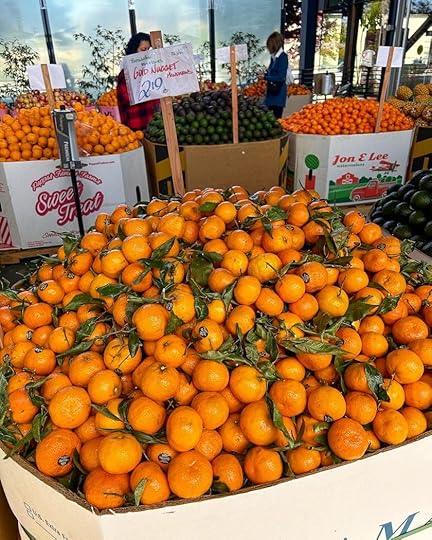

From there, Craig and I headed over to grab lunch at Fava — another spot recommended by Toby, from two Chez Panisse alumns — and their falafel sandwich was simple and surprising, with various textures and flavors and an embarrassment of herbs.


After that, we checked out The Cheese Board Collective, a Berkeley institution. Toby made me promise him I’d visit and grab a pastry: I chose a corn cherry scone and it was out-of-this-world.
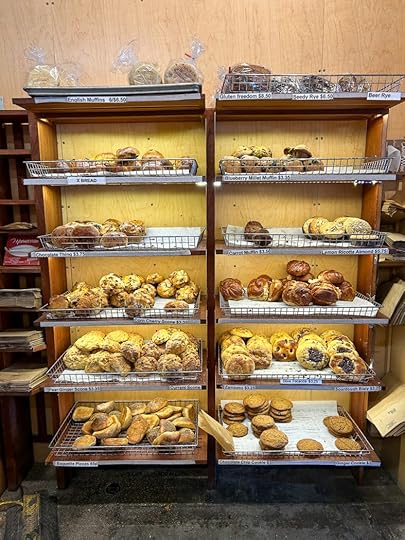
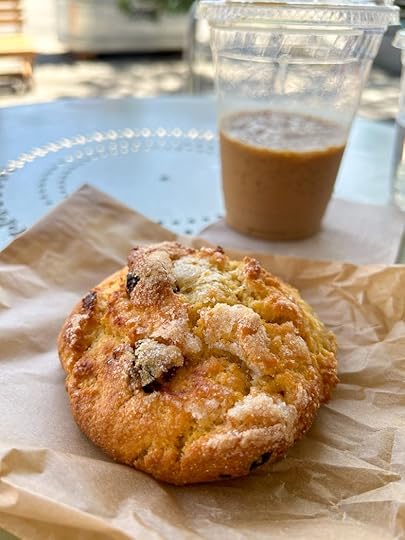
Well-fed and eager to get on, we hit the road for the two hour drive north to Sonoma.
Now the big splurge that I made for this trip was using almost five years of American Express points to book a swanky hotel (at some point, you’ve gotta use them!): so I settled on The Farmhouse Inn, which was lovely and cozy all at once.

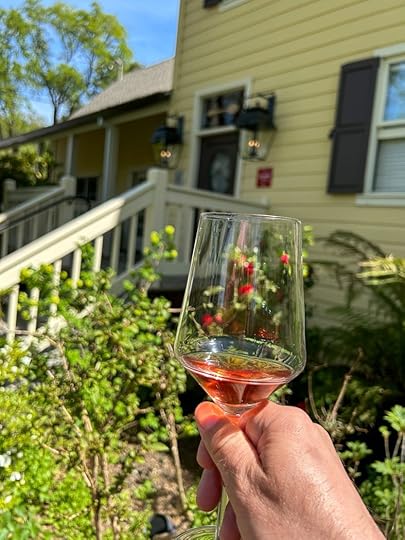
Our room was directly over a Michelin-starred restaurant and originally we were going to skip it to get dinner at Glen Ellen Star, about forty minutes away. But that afternoon, we went to a wine tasting on the hotel grounds (one of the perks of staying at a nice place in Sonoma) hosted by Kathryn Sloan of Smallvines Vineyards.


After sampling and buying a few bottles (how could we not?), we told her our dinner plan and she was shocked that we weren’t eating at the hotel. “My husband and I eat all over Sonoma all the time, and it’s our favorite restaurant, hands down.” Considering that we were buzzed from the wine and preferred walking down a flight of stars to driving for forty minutes, we agreed that the hotel made more sense.


The meal itself was super pricey ($225 a person, to be specific) but it was our blow-out meal at our blow-out hotel and the food was truly above reproach, if not downright spectacular. The chef trained at many prestigious institutions (including Atelier Crenn) and the attention to detail was undeniable. We also did a wine pairing which was so extravagant and interesting, I started a new Instagram account just to write about it.
That night we stumbled upstairs to bed and slept happily dreaming about caviar covered asparagus with onion flowers and grilled steak with pressed pickled Daikon radish with herbs.
Day Four: A Day in SonomaThe next morning, we ate breakfast once again downstairs at the hotel. This time we sat outside and enjoyed some Eggs Benny before heading out for the day.


We drove over to Guerneville, which we’d heard a lot about (mostly from our gay friends). We walked around and saw some antiques and a river and a cute book store.
From there, we went to a one o’clock wine tasting at Ryme Vineyards, which came highly recommended from the hotel.


Turns out wine tastings are just opportunities to sit in lovely spaces and drink wine while gossiping about the people next to you. (A table of six women and two men amused us because the men were bored out of their minds, staring at their phones; one of them left.)
The wine at Ryme was excellent: our favorite was a Sangiovese Friulano, which was a deep dark red rosé. We bought a few bottles. From there, we went back to the hotel and swam for a bit and finally made our way into town for our final dinner of the trip, at The Matheson.


I’m so glad we wound up here: not only was the food great, but before dinner we partook of “the wall of wine.” You basically give them your credit card, they give you a wine card, and then you can go along an enormous wall and use the card to try splashes, 1/2 glasses, or full glasses of over ninety different wines. At first my card didn’t work, and when I showed the handsome bartender he said: “Sir, that’s your hotel room key.”


All of the food at the Matheson was top notch (though they ran out of bread by the time we got there, and it looked so good!). Loved my steelhead trout with a clam-infused sauce and that Baba au Rhum for dessert was Baba au righteous. (We ordered a bottle of Flowers Chardonnay which was a great discovery; next time, we’ll visit their vineyard too.)
Day Five: The Journey HomeAnd yesterday, our last day, we had breakfast at the hotel and then started the long drive back.
This time we didn’t take the scenic 101; we were eager to get home to our dog, so we took the not-so-scenic 5. We listened to some podcasts (highly recommend Randy Newman on vintage Desert Island Discs) and before we knew it, we were back in L.A.
What a fun road trip! If this was our farewell-to-California tour, I don’t think we could’ve done much better.
The post Wining and Dining Our Way Up the California Coast, from Los Angeles to Sonoma appeared first on The Amateur Gourmet.
April 17, 2023
Holy Sheet Pan Pizza
Some people see the light and get religion. Other people see the light and get sheet pan pizza. That’s what happened to me this past Friday night when I cooked up the best sheet pan pizza of my life here in my own apartment, setting off a smoke detector and freaking out the dog in the process, but oh was it worth it. (Sorry, Winston.) Now that I know how to make a killer sheet pan pizza, I plan to make sheet pan pizza on the regular.
There’s No Knead, There’s None
Basically this recipe is a combination of two recipes: Deb Perelman’s, from her new terrific cookbook, Smitten Kitchen Keepers and Carla Lalli Music’s from Bon Appetit and this video, which I found very helpful.
From Deb, I gleaned that you don’t need to work the dough. Just combine the flour, yeast, oil, and salt, let it rise for a bit, and then refrigerate overnight. When you’re ready, let it come to room temperature for ten minutes, and you’re good to go.

Is there anything more satisfying that finding a giant blob of pizza dough ready to go in your refrigerator on a Friday night? I think not!
It’s a Stretch
Once the dough was on my massage table — aka: the sheet pan — it was slathered with so much oil, it probably thought it was getting a happy ending. The Carla Lalli Music recipe tells you to pour 1/2 cup of olive oil onto the sheet pan (and both of ours are 18 X 13, though at first I thought hers was bigger) and the idea is that the oil helps get you that crispy bottom that makes sheet pan pizza so good. Personally, I thought it was too much… but then again: it was an amazing pizza.
The name of the game is stretching the dough into the corners. I did a great job of stretching the dough in general, but getting it into those corners took work. The secret is counterintuitive. You think you need to keep working on it, but actually you need to step away for the gluten to relax. Eventually you’ll get there.
Choose Your Own Sheet Pan Pizza
There are lots of theories about what to put on your homemade pizza, but I subscribe to the raw sauce theory. As in: don’t put cooked tomato sauce on your pizza. Instead, strain a can of tomatoes and put the tomatoes in a food processor with garlic, anchovies, olive oil, and basil and blitz. The tomatoes will concentrate in the oven and you’ll get something truly great.
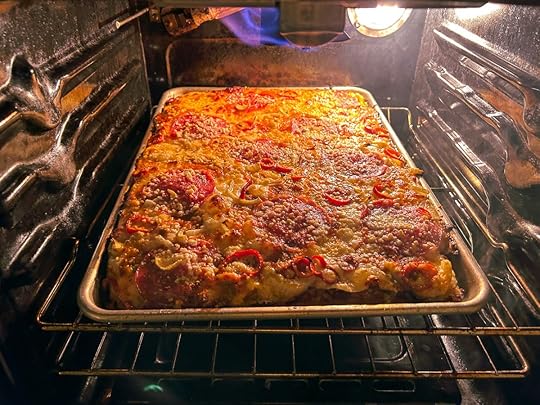
Both Deb’s pizza and Carla’s pizza have soppressata, fennel, mozzarella, Pecorino, and chilies. Mine were homemade pickled Fresno chilies because that’s just how I roll. What you’re seeing in the above pic was my decision to broil the pizza towards the end to get the cheese nice and bronzed. As for the bottom of the pie…

…I was scared it was going to burn, but in just fifteen minutes at 550 degrees, the only thing that burned was a little cheese towards the top. The bottom was golden and crisp, like your favorite focaccia.
And that’s how to think of this pizza. It’s like the love child of a deep-dish pizza and a focaccia and, hot out of the oven, it’s just as good as any pizza you could have delivered. Next time I’m playing around with the toppings (maybe anchovies, chilies, and olives?) and, more importantly, disabling my smoke detector. Let that cheese burn in peace.

 PrintHoly Sheet Pan PizzaA combo of two different recipes, this is my new favorite go-to Friday night pizza-at-home recipe.Course Main CourseCuisine ItalianKeyword pizzaPrep Time 1 dayCook Time 1 hourServings 12 slicesIngredientsFor the dough:2 cups warm water (not hotter than 116 F)1 packet instant yeast (2 1/4 teaspoons)2 teaspoons kosher salt1 tablespoon olive oil4 cups all-purpose flourFor the sauce:1 28-ounce can San Marzano tomatoes, drained2 anchovy filets (optional, but they add some pizazz)2 garlic cloves6 tablespoons extra-virgin olive oil1/4 cup fresh basil leavesKosher saltFor the pizza: 1/2 cup olive oil + more for drizzling on top12 ounces shredded mozzarella cheese You should probably use fresh and shred it yourself, but I bought the pre-shredded stuff and thought it was great4 ounces soppressata, thinly sliced1/2 small fennel bulb, thinly sliced, fronds reserved2 fresh red chilies thinly sliced I used pickled red chilies which worked great1/2 cup grated Pecorino RomanoInstructionsThe night before you want to make your pizza, whisk together the warm water and the yeast in a large bowl. Let sit for a few minutes and as soon as you see small bubbles, add the salt, olive oil, and all-purpose flour and combine with a rubber spatula. Grease another large bowl with olive oil and transfer the dough to the new bowl. Set it aside for 1 1/2 hours and as soon as it's almost doubled, cover with plastic and refrigerate overnight. (Note: you can actually use this dough day-of when it doubles, it's just more flavorful after a night of fermentation.)Heat your oven to 500 degrees, or as hot as it will go. While it's heating, make your sauce by combining the drained tomatoes, anchovies, garlic, extra-virgin olive oil, basil, and a pinch of salt in a food processor, pulsing just until combined. (You don't want to aerate it.) Taste and adjust for seasoning.Pour the 1/2 cup olive oil on to an 18 X 13 cookie sheet and spread all around. Remove your dough from the refrigerator and transfer it to the sheet, allowing it to warm up for fifteen minutes before beginning to stretch. Gently start pulling at the dough, trying to get it to cover the width of the sheet. If it gives you any trouble, just step away for a few minutes and let the gluten relax. Continue stretching until you have the dough reaching all four sides and all four corners.Now's the fun part: topping the pizza. Sprinkle the entire surface with the mozzarella cheese. Then dot with small spoonfuls of the tomato sauce in various spots, making sure not to overdo it (you don't want soggy pizza). Use about a cup. After that, lay on your soppressata and your fennel and scatter with the chilies. Sprinkle with the Pecorino Romano and drizzle with a little more olive oil. Bake in the hot oven for 15 to 20 minutes, until the cheese is melted and the bottom of the crust is golden brown (you should use a spatula to test it before removing it from the oven). If you want an extra burnished top, turn on the broiler and let it go until the cheese starts to turn golden. Remove from the oven and garnish with the reserved fennel fronds. You can serve it in the pan or carefully transfer it to a large cutting board and slice it into twelve large pieces. I'd tell you how to reheat the leftovers, but you won't have any.
PrintHoly Sheet Pan PizzaA combo of two different recipes, this is my new favorite go-to Friday night pizza-at-home recipe.Course Main CourseCuisine ItalianKeyword pizzaPrep Time 1 dayCook Time 1 hourServings 12 slicesIngredientsFor the dough:2 cups warm water (not hotter than 116 F)1 packet instant yeast (2 1/4 teaspoons)2 teaspoons kosher salt1 tablespoon olive oil4 cups all-purpose flourFor the sauce:1 28-ounce can San Marzano tomatoes, drained2 anchovy filets (optional, but they add some pizazz)2 garlic cloves6 tablespoons extra-virgin olive oil1/4 cup fresh basil leavesKosher saltFor the pizza: 1/2 cup olive oil + more for drizzling on top12 ounces shredded mozzarella cheese You should probably use fresh and shred it yourself, but I bought the pre-shredded stuff and thought it was great4 ounces soppressata, thinly sliced1/2 small fennel bulb, thinly sliced, fronds reserved2 fresh red chilies thinly sliced I used pickled red chilies which worked great1/2 cup grated Pecorino RomanoInstructionsThe night before you want to make your pizza, whisk together the warm water and the yeast in a large bowl. Let sit for a few minutes and as soon as you see small bubbles, add the salt, olive oil, and all-purpose flour and combine with a rubber spatula. Grease another large bowl with olive oil and transfer the dough to the new bowl. Set it aside for 1 1/2 hours and as soon as it's almost doubled, cover with plastic and refrigerate overnight. (Note: you can actually use this dough day-of when it doubles, it's just more flavorful after a night of fermentation.)Heat your oven to 500 degrees, or as hot as it will go. While it's heating, make your sauce by combining the drained tomatoes, anchovies, garlic, extra-virgin olive oil, basil, and a pinch of salt in a food processor, pulsing just until combined. (You don't want to aerate it.) Taste and adjust for seasoning.Pour the 1/2 cup olive oil on to an 18 X 13 cookie sheet and spread all around. Remove your dough from the refrigerator and transfer it to the sheet, allowing it to warm up for fifteen minutes before beginning to stretch. Gently start pulling at the dough, trying to get it to cover the width of the sheet. If it gives you any trouble, just step away for a few minutes and let the gluten relax. Continue stretching until you have the dough reaching all four sides and all four corners.Now's the fun part: topping the pizza. Sprinkle the entire surface with the mozzarella cheese. Then dot with small spoonfuls of the tomato sauce in various spots, making sure not to overdo it (you don't want soggy pizza). Use about a cup. After that, lay on your soppressata and your fennel and scatter with the chilies. Sprinkle with the Pecorino Romano and drizzle with a little more olive oil. Bake in the hot oven for 15 to 20 minutes, until the cheese is melted and the bottom of the crust is golden brown (you should use a spatula to test it before removing it from the oven). If you want an extra burnished top, turn on the broiler and let it go until the cheese starts to turn golden. Remove from the oven and garnish with the reserved fennel fronds. You can serve it in the pan or carefully transfer it to a large cutting board and slice it into twelve large pieces. I'd tell you how to reheat the leftovers, but you won't have any.The post Holy Sheet Pan Pizza appeared first on The Amateur Gourmet.
April 16, 2023
Eggs on a Green Blanket
Iconic dish names have to start somewhere. Who invented Toad in the Hole? Chicken a la King? S’mores? I’m sure they all have stories, and if we had more time we could research those stories, but my point is that sometimes a dish needs an official name. And that’s why I Christen (what’s the Jewish version of Christen? Bar Mitzvah?)… I Bar Mitzvah this dish: Eggs on a Green Blanket.
A Green Blanket Needs Greens
Not to be one of those people who say “first, I went to the farmer’s market,” but… first, I went to the farmer’s market. And I gathered up three bunches of greens: one a bunch of collards, one a bunch of Tuscan kale, and one a bunch of Swiss chard.
The next twenty minutes was spent washing the greens, stemming the greens, and slicing the greens. Pleasant work, especially when you’re listening to West Side Story.
Cook Your Greens and Add More Greens
This recipe is inspired by one in Gregory Gourdet’s award-winning cookbook, Everyone’s Table. That one also features ginger and chilies in the base, but here we stick to just garlic (lots of it) and the Swiss chard stems. Once those are sautéed and starting to toast, you start adding your greens by the handful.

What you’ll quickly learn, if you’ve never cooked greens before, is that what you thought was a lot of greens will quickly become not-a-lot-of-greens because they cook down. What’s fun about cooking greens, is you can put them in wet from their wash and that’ll help with the wilting process.
Let’s Put the Eggs on a Green Blanket
Once your greens are nicely cooked down and seasoned (taste as you go, people), it’s time to crack on the eggs. If you’re nervous, you can crack the eggs into a little bowl and tip them on. Or if you’re bold just crack the eggs directly on top. Then you bake in a 450 oven for seven minutes or so, just until the whites are set and the yolks are still runny. At the end, I dusted everything with Aleppo pepper and lots of herbs (basil, dill, parsley, and chives).

Now is that an iconic dish or is that an iconic dish?
Eggs on a green blanket. Say it with me, teach it to your children. One day it’ll be a menu staple.
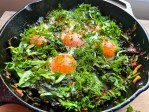 PrintEggs on a Green BlanketAn easy recipe for eggs baked on a blanket of greens inspired by Gregory Gourdet's Everyone's Table.Course BreakfastCuisine AmericanKeyword collards, greens, Gregory Gourdet, kale, Swiss chardPrep Time 30 minutesCook Time 30 minutesServings 2 hungry peopleIngredients1 small bunch collard greens1 small bunch kale (any kind you like)1 small bunch Swiss chard1/2 cup extra-virgin olive oil6 cloves garlic, peeled and thinly slicedKosher salt6 large eggsAleppo pepperHandful of mixed herbs, such as basil, parsley, dill, and chivesInstructionsPreheat your oven to 450. Remove the stems from the collards, kale, and Swiss chard, reserving the chard stems. Chop the chard stems (set aside) and cut the greens into 1-inch wide strips. Rinse the chopped greens in a bowl of cold water to get any dirt off and then lift into a colander, leaving all the dirt behind. (No need to dry them.)Heat the oil in a 9-inch to 12-inch cast-iron skillet over medium heat. Add your garlic and sauté for 30 seconds; then add the chard stems and a pinch of salt. Cook for a minute or so just until the garlic starts to turn golden. Start adding your greens a handful at a time, with a small pinch of salt, stirring all around. Cook until they're good and wilted and then add the next handful. Keep going like this until all of the greens are cooked down and taste good (adjust for salt).Off the heat, crack six eggs on top of the greens. Season with salt and pepper and bake in the 450 oven for 7 to 10 minutes, just until the whites are set, but the yolks are still runny. Sprinkle with Aleppo pepper and all the herbs and serve right away.
PrintEggs on a Green BlanketAn easy recipe for eggs baked on a blanket of greens inspired by Gregory Gourdet's Everyone's Table.Course BreakfastCuisine AmericanKeyword collards, greens, Gregory Gourdet, kale, Swiss chardPrep Time 30 minutesCook Time 30 minutesServings 2 hungry peopleIngredients1 small bunch collard greens1 small bunch kale (any kind you like)1 small bunch Swiss chard1/2 cup extra-virgin olive oil6 cloves garlic, peeled and thinly slicedKosher salt6 large eggsAleppo pepperHandful of mixed herbs, such as basil, parsley, dill, and chivesInstructionsPreheat your oven to 450. Remove the stems from the collards, kale, and Swiss chard, reserving the chard stems. Chop the chard stems (set aside) and cut the greens into 1-inch wide strips. Rinse the chopped greens in a bowl of cold water to get any dirt off and then lift into a colander, leaving all the dirt behind. (No need to dry them.)Heat the oil in a 9-inch to 12-inch cast-iron skillet over medium heat. Add your garlic and sauté for 30 seconds; then add the chard stems and a pinch of salt. Cook for a minute or so just until the garlic starts to turn golden. Start adding your greens a handful at a time, with a small pinch of salt, stirring all around. Cook until they're good and wilted and then add the next handful. Keep going like this until all of the greens are cooked down and taste good (adjust for salt).Off the heat, crack six eggs on top of the greens. Season with salt and pepper and bake in the 450 oven for 7 to 10 minutes, just until the whites are set, but the yolks are still runny. Sprinkle with Aleppo pepper and all the herbs and serve right away.The post Eggs on a Green Blanket appeared first on The Amateur Gourmet.
Adam D. Roberts's Blog
- Adam D. Roberts's profile
- 3 followers



